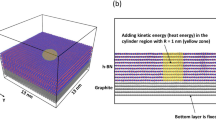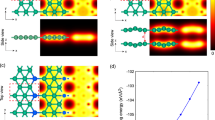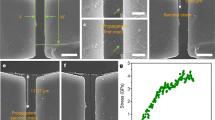Abstract
The combination of vertical and in-plane heterostructures will create unprecedented structures that may produce novel physical properties. In this study, the failure mechanism of a bilayer Gr/h-BN staggered stacked heterostructure (BGBN-SS) with different interlayer sp3 bonds, different interface connection, and various defects has been investigated. The results show that interlayer sp3 bonds and various defect affect the failure mechanism of BGBN-SS in two contrary ways. The sp3 bonds raise the primary strain of the BGBN-SS-containing various defects and different interface connection, and can weaken tensile stresses and strain and Young’s modulus. However, the creation of interlayer bonding leads the bilayer heterostructure gradually changed to “quasi three-dimensional” structure. The stronger interlayer interaction induced by sp2–sp3 bonds in “quasi three-dimensional” structure can strengthen the interlayer shell modulus and load transfer rate. In addition, the mechanical properties of interface C–N bonding are greater than that of interface C–B bonding, indicating that C–N bonding at interface could improve the stability and ductility of the composite effectively. The square nanoholes are more likely to accumulate the local stress of the system, compared with circular nanoholes. The changing of sp2 hybridization of interlayer bonds transforms to a weak hybrid sp3 bonds. As a result, the special defects (interlayer bonding) introduce a new stress transfer mode (different from vdW heterostructures and in-plane hybrid nanostructures.













Similar content being viewed by others
References
A.K. Geim, I.V. Grigorieva, Van der Waals heterostructures. Nature 499(7459), 419–425 (2013)
Y. Liu, Y. Huang, X.F. Duan, Van der Waals integration before and beyond two-dimensional materials. Nature 567(7748), 323–333 (2019)
E.M. Alexeev, D.A. Ruiz-Tijerina, M. Danovich et al., Resonantly hybridized excitons in moire superlattices in van der Waals heterostructures. Nature 567(7746), 81 (2019)
K.S. Novoselov, A. Mishchenko, A. Carvalho et al., 2D materials and van der Waals heterostructures. Science 353(6298), aac9439 (2016)
J.E. Barrios-Vargas, B. Mortazavi, A.W. Cummings et al., Electrical and Thermal transport in coplanar polycrystalline graphene–hBN heterostructures. Nano Lett. 17(3), 1660–1664 (2017)
L. Britnell, R.V. Gorbachev, R. Jalil et al., Field-effect tunneling transistor based on vertical graphene heterostructures. Science 335(6071), 947–950 (2012)
L. Liu, J. Park, D.A. Siegel et al., Heteroepitaxial growth of two-dimensional hexagonal boron nitride templated by graphene edges. Science 343(6167), 163–167 (2014)
X.J. Liu, J.F. Gao, G. Zhang et al., Design of phosphorene/graphene heterojunctions for high and tunable interfacial thermal conductance. Nanoscale 10(42), 19854–19862 (2018)
L. Fan, W.J. Yao, Effect of defects on mechanical properties of planar h-BN-graphene heterostructure. Mater Res Express 6, 105613 (2019)
D. Wang, G. Chen, C. Li et al., Thermally induced graphene rotation on hexagonal boron nitride. Phys. Rev. Lett. 116, 126101 (2016)
G. Argentero, A. Mittelberger, M.R.A. Monazam et al., Unraveling the 3D atomic structure of a suspended graphene/hBN van der waals heterostructure. Nano Lett. 17, 1409–1416 (2017)
K. Kim, M. Yankowitz, B. Fallahazad et al., van der Waals heterostructures with high accuracy rotational alignment. Nano Lett. 16, 1989–1995 (2016)
J. Zhang, Y. Hong, Y. Yue et al., Thermal transport across graphene and single layer hexagonal boron nitride. J. Appl. Phys. 117, 134307 (2015)
M.Y. Li, B. Zheng, K. Duan et al., Effect of defects on the thermal transport across the graphene/hexagonal boron nitride interface. J. Phys. Chem. C 122, 14945–14953 (2018)
L.A. Chernozatonskii, G.K. Dmitry, P.B. Sorokin et al., Strong influence of graphane island configurations on the electronic properties of a mixed graphene/graphane superlattice. J. Phys. Chem. C 116(37), 20035–20039 (2012)
L.A. Chernozatonskii, D.G. Kvashnin, O.P. Kvashnina et al., Similarity in band gap behavior of modified graphene with different types of functionalization. J. Phys. Chem. C 118(2), 1312–1318 (2014)
L. Menyoung, R. John, P.G. Wallbank et al., Ballistic miniband conduction in a graphene superlattice. Science 353, 1526–1529 (2016)
S. Dai, Q. Ma, M.K. Liu et al., Graphene on hexagonal boron nitride as a tunable hyperbolic metamaterial. Nat. Nanotechnol. 10(8), 682–686 (2015)
D.G. Kvashnin, O.P. Kvashnina, P.V. Avramov et al., Novel hybrid C/BN two-dimensional heterostructures. Nanotechnology 28(8), 085205 (2017)
D.G. Kvashnin, S. Bellucci, L.A. Chernozatonskii et al., Sharp variations in the electronic properties of graphene deposited on the h-BN layer. Phys. Chem. Chem. Phys. 17(6), 4354–4359 (2015)
A.R. Muniz, D. Maroudas, Formation of fullerene superlattices by interlayer bonding in twisted bilayer graphene. J. Appl. Phys. 111(4), 043513 (2012)
L.A. Chernozatonskii, P.B. Sorokin, A.G. Kvashnin et al., Diamond-like C2H nanolayer, diamane: simulation of the structure and properties. JETP Lett. 90(2), 134–138 (2009)
A.G. Kvashnin, L.A. Chernozatonskii, B.I. Yakobson et al., Phase diagram of quasi-two-dimensional carbon, from graphene to diamond. Nano Lett. 14(2), 676–681 (2014)
L.A. Chernozatonskii, P.B. Sorokin, A.A. Kuzubov et al., Influence of size effect on the electronic and elastic properties of diamond films with nanometer thickness. J. Phys. Chem. C 115(1), 132–136 (2011)
A.R. Muniz, D. Maroudas, Opening and tuning of band gap by the formation of diamond superlattices in twisted bilayer graphene. Phys. Rev. B 86(7), 075404 (2012)
M.P. Levendorf, C. Kim, L. Brown et al., Graphene and boron nitride lateral heterostructures for atomically thin circuitry. Nature 488(7413), 627–632 (2012)
L. Fan, W. Yao, Effect of interlayer sp 3 bonds and nanopores on mechanical properties of vertically-stacked 2D heterostructures. Mater. Res. Express 6, 105618 (2019)
E.E. Kasra, S. Sadegh, J. Maisam, Mechanical properties of defective hybrid graphene-boron nitride nanosheets: a molecular dynamics study. Comput. Mater. Sci. 149, 170–181 (2018)
Y.Y. Zhang, C.M. Wang, Y. Chen et al., Mechanical properties of bilayer graphene sheets coupled by sp3 bonding. Carbon 49, 4511–4517 (2011)
W.J. Yao, L. Fan, Research on the correlation of mechanical properties of BN–graphene–BN/BN vertically-stacked nanostructures in the presence of interlayer sp3 bonds and nanopores with temperature. Phys. Chem. Chem. Phys. 22, 5920 (2020)
Y.F. Li, A.R. Wei, H. Ye et al., Mechanical and thermal properties of grain boundary in a planar heterostructure of graphene and hexagonal boron nitride. Nanoscale 10, 3497 (2018)
M.F. Isaac, F.C. Luiz, Pereira thermal conductivity of graphene-hBN superlattice ribbons. Sci. Rep. 8, 2737 (2018)
M. Neek-Amal, F.M. Peeters, Graphene on boron-nitride: moire pattern in the van der Waals energy. Appl. Phys. Lett. 104, 041909 (2014)
L. Fan, W.J. Yao, Mechanical properties of a G/h-BN heterobilayer nanosheets coupled by interlayer sp3 bonds and defects. Mater. Res. Express 6, 095075 (2019)
A. Kınaci, J.B. Haskins, C. Sevik et al., Thermal conductivity of BN-C nanostructures. Phys. Rev. B 86, 115410 (2012)
T. Iwata, K. Shintani, Reduction of the thermal conductivity of a graphene/hBN heterobilayer via interlayer sp3 bonds. Phys. Chem. Chem. Phys. 20, 5217 (2018)
J. Huheey, T. Cottrell, The strengths of chemical bonds (Butterworths, London, 1958)
A. Rajabpour, S.M.V. Allaei, Tuning thermal conductivity of bilayer graphene by interlayer sp3 bonding: a molecular dynamics study. Appl. Phys. Lett. 101, 053115 (2012)
Y.Y. Zhang, Y.T. Gu, Mechanical properties of graphene: effects of layer number, temperature and isotope. Comput. Mater. Sci. 71, 197–200 (2013)
H. Li, H. Zhang, X.L. Cheng, The effect of temperature, defect and strain rate on the mechanical property of multi-layer graphene: coarse-grained molecular dynamics study. Phys. E 85, 97–102 (2017)
X.K. Chen, K.Q. Chen, Thermal transport of carbon nanomaterials. J. Phys. Condens. Matter 32, 153002 (2020)
X.K. Chen, M. Pang, T. Chen et al., Thermal rectification in asymmetric graphene/hexagonal boron nitride van der Waals heterostructures. ACS Appl. Mater. Interfaces 12, 15517–15526 (2020)
Acknowledgements
This work was supported by a National Natural Science Foundation of China (11572186).
Author information
Authors and Affiliations
Corresponding authors
Ethics declarations
Conflict of interest
No potential conflict of interest was reported by the authors.
Additional information
Publisher's Note
Springer Nature remains neutral with regard to jurisdictional claims in published maps and institutional affiliations.
Rights and permissions
About this article
Cite this article
Fan, L., Yao, W. & Zhang, Z. Regulation of failure mechanism of a bilayer Gr/h-BN staggered stacked heterostructure via interlayer sp3 bonds, interface connection, and defects. Appl. Phys. A 126, 752 (2020). https://doi.org/10.1007/s00339-020-03895-7
Received:
Accepted:
Published:
DOI: https://doi.org/10.1007/s00339-020-03895-7




